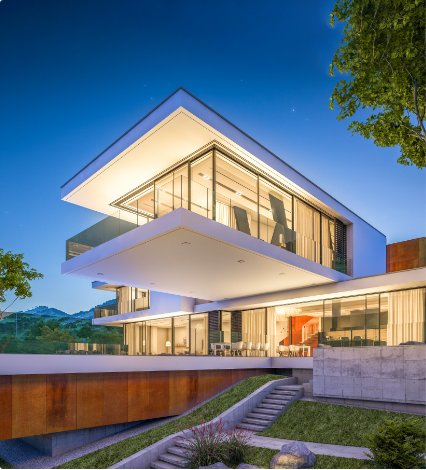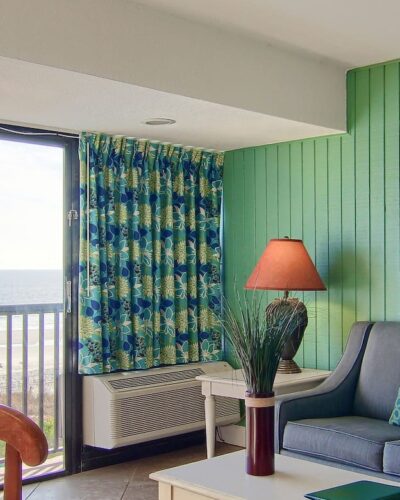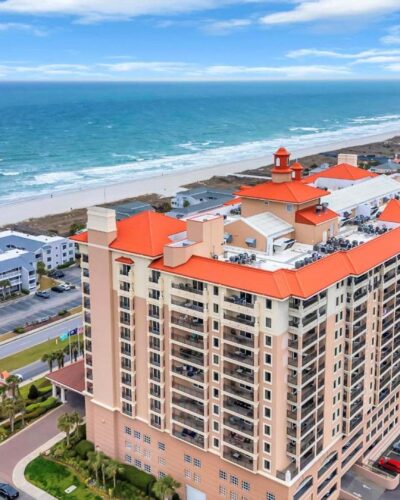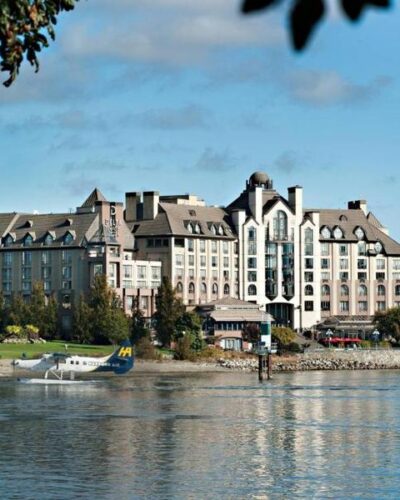Toronto is the largest city in Canada and it’s home to some of the country’s best-loved tourist attractions, including the Royal Ontario Museum, the CN Tower, and the Art Gallery of Ontario. It also offers fantastic nightlife and plenty of opportunities for shopping.
If you’re planning a trip to Toronto, you might wonder which part of the city to stay in. There’s plenty of choice when it comes to hotels, guesthouses, and hostels, but each district has its own set of pros and cons. Here’s a rundown of the best neighborhoods in Toronto for tourists and visitors to help you decide which area to stay in.
Entertainment District & Financial District for Sightseeing

Highlights: CN Tower, Ripley’s Aquarium of Canada, The Rogers Centre, Toronto Railway Museum, Roy Thomson Hall, Scotiabank Arena, Royal Alexandra Theatre, Princess of Wales Theatre, Hockey Hall of Fame
Downtown Toronto comprises several neighborhoods, but at its core are the Entertainment District and the Financial District. This is the busiest part of the city, with people flocking to the area to work, party, and see the sights. The area is packed with slick high-rise office and apartment buildings, and there’s no shortage of restaurants and bars to enjoy. You can easily get around on foot via the extensive underground walkway called PATH.
Key sights in the Entertainment and Financial Districts include the CN Tower, Rogers Centre baseball stadium, and Ripley’s Aquarium. King Street is the main drag of the Entertainment District and it’s the perfect spot to grab dinner before catching a show at one of Toronto’s theaters or concert halls.
If you’re a first-time visitor and plan to check out the city’s main tourist attractions you’ll definitely be spending lots of time in this part of Downtown, so it makes sense to stay here. Union Station is a hub for public transport in this area so it’s easy to get around the rest of the city. Some of Toronto’s best hotels are in this neighborhood, including the St. Regis Toronto and the Shangri-La.
Yonge-Dundas for Shopping
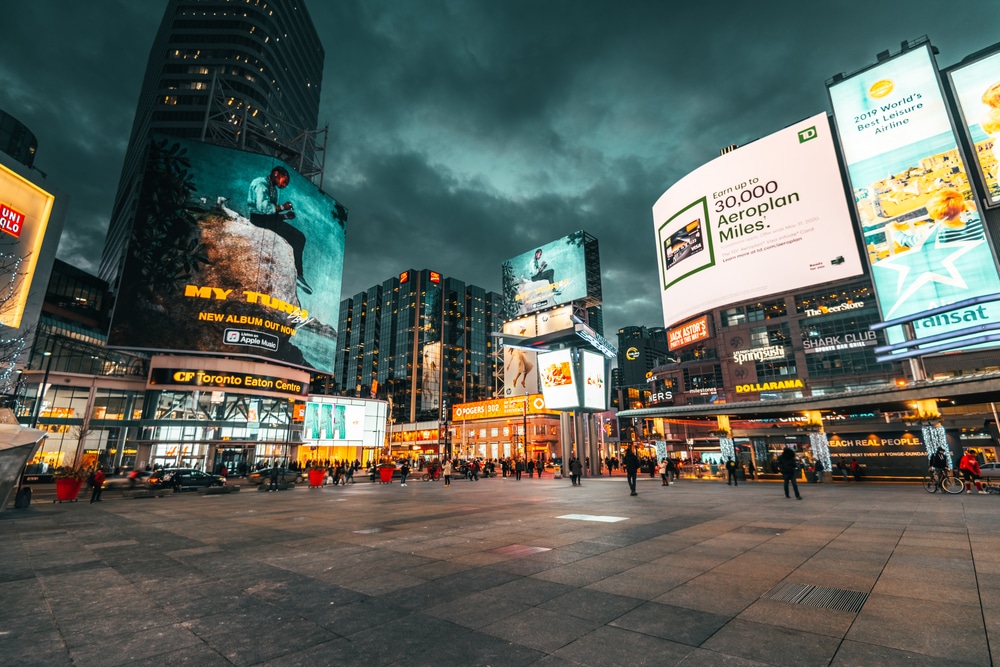
Highlights: Yonge-Dundas Square, Art Gallery of Ontario, Textile Museum of Canada, Maple Leaf Gardens, Massey Hall, Elgin and Winter Garden Theatre, Eaton Centre, Royal Ontario Museum, St. Lawrence Market
Just north of the Entertainment District is the Yonge-Dundas District of Downtown. It comprises multiple micro-neighborhoods and encompasses a large shopping area. Yonge-Dundas Square is a bustling public courtyard surrounded by flashy billboards and stores, and there’s always a great atmosphere much like New York’s Times Square.
The Eaton Centre shopping mall on Yonge Street is a popular attraction, and the streets surrounding it are also packed with shops and boutique stores. Another beloved shopping spot, this time for food, is St. Lawrence Market. There are also several legendary entertainment venues in the area, including Massey Hall, the Ed Mirvish Theatre, and Elgin and Winter Garden Theatre.
Yonge-Dundas is a very walkable area with no shortage of eateries and bars. There’s a good mix of hotels here, including midrange options such as the Chelsea Hotel and Marriott Downtown.
Midtown and Yorkville for Luxury
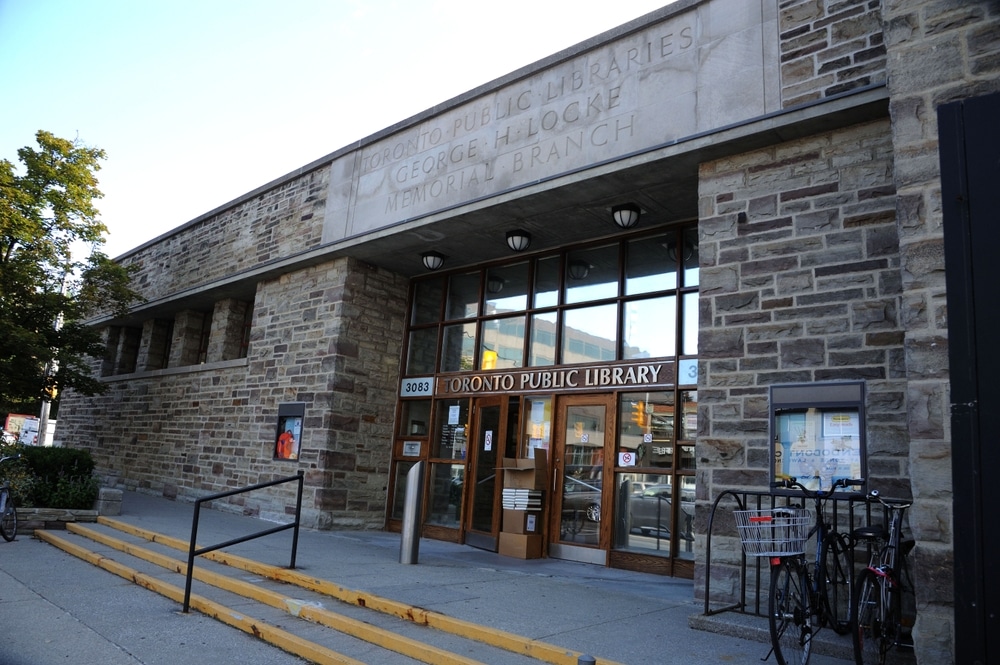
Highlights: Mink Mile, Bata Shoe Museum, Casa Loma, Toronto Public Library
Just north of Downtown Toronto is Midtown which has an interesting blend of new and old buildings. Like Downtown, it comprises multiple smaller neighborhoods. Yorkville is a particularly glamorous area that’s popular with celebrities. It is best known for its Mink Mile, one of the world’s most expensive shopping streets. This is where you can find the stores of several high-end designer brands including Chanel and Burberry.
Yorkville’s streets are lined with trees and beautiful Victorian mansions, so if you’re looking for a picturesque part of the city to stay in, this is a great option. There are several parks in the area and a couple of museums, including the Bata Shoe Museum which displays a collection of footwear that spans 4,500 years of history.
Given the central position of Midtown and Yorkville, you’ll have easy access to the main sights when you stay in these areas. If you want an opulent vacation in Toronto City, you’ll definitely find it in Yorkville. There are several luxury hotels here including The Park Hyatt. Slightly more affordable options are available in the wider Midtown area.
Old Town for Grand Architecture
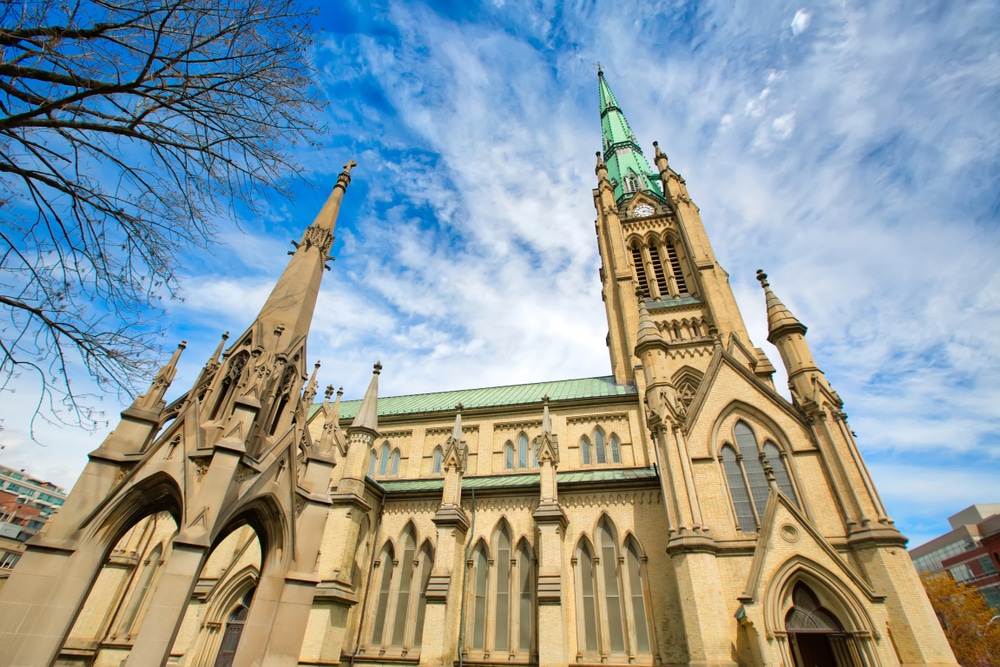
Highlights: Museum of Illusions, First Toronto Post Office, St. James Anglican Cathedral, Toronto Old City Hall
East of Downtown is Toronto’s Old Town — the original 10 blocks that formed the city when it was founded in the late 18th Century. You’ll see plenty of traces of Victorian architecture in Old Town, including St. James Anglican Cathedral and the First Toronto Post Office.
The neighboring Distillery District is a popular area for tourists to explore. The Victorian industrial distillery buildings here have been converted into independent boutiques and art galleries. Nearby Corktown, which is primarily residential, has more examples of Victorian architecture including St. Paul’s Basilica and Little Trinity Church.
Old Town is a small area with only a few mid range hotels available, but if you cast your net to the surrounding neighborhoods you might find some quiet vacation rentals like Cambridge Suites. This is a good area to stay in if you’re fascinated by historic Toronto and want to soak in the attractive Victorian architecture.
Harbourfront & Toronto Islands for Family Holidays
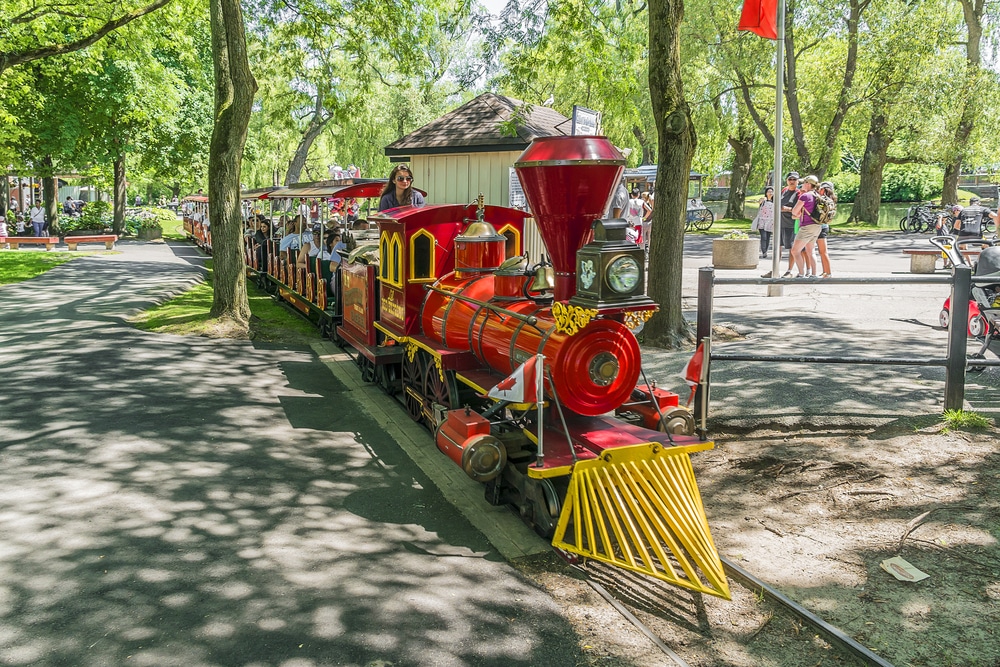
Highlights: Centreville Amusement Park, white sand beaches, Gibraltar Point Lighthouse, St. Andrews by the Lake Church, Power Plant Contemporary Art Gallery, Harbour Square Park
Harbourfront lies on the shores of Lake Ontario and is one of the most scenic parts of Toronto. There’s no shortage of parks, trails, and beaches to enjoy in Harbourfront, as well as bars, restaurants, and cafes situated right on the waterfront. Harbourfront Centre regularly hosts events centering around food, music, and art so look out for these during your visit.
From Harbourfront you can take a ferry to the famed Toronto Islands, a chain of islets that sit just offshore. The islands are popular with families thanks to the presence of Centreville Amusement Park on Centre Island, which also features a petting zoo and an old lighthouse. If you want a lazy day on the beach, Toronto Islands is the perfect place to do it. Head to the Toronto Skyline observation deck for incredible views of the city.
There are only a few hotels in Harbourfront but look just north of the area for more choice. The Delta by Marriott is one of the best options in this neighborhood.
This part of the city is great for families who expect to spend lots of time on the Toronto Islands or out on the lake. Harbourfront also benefits from being within walking distance of Downtown and many of the city’s biggest attractions.
Westside for Urban Art
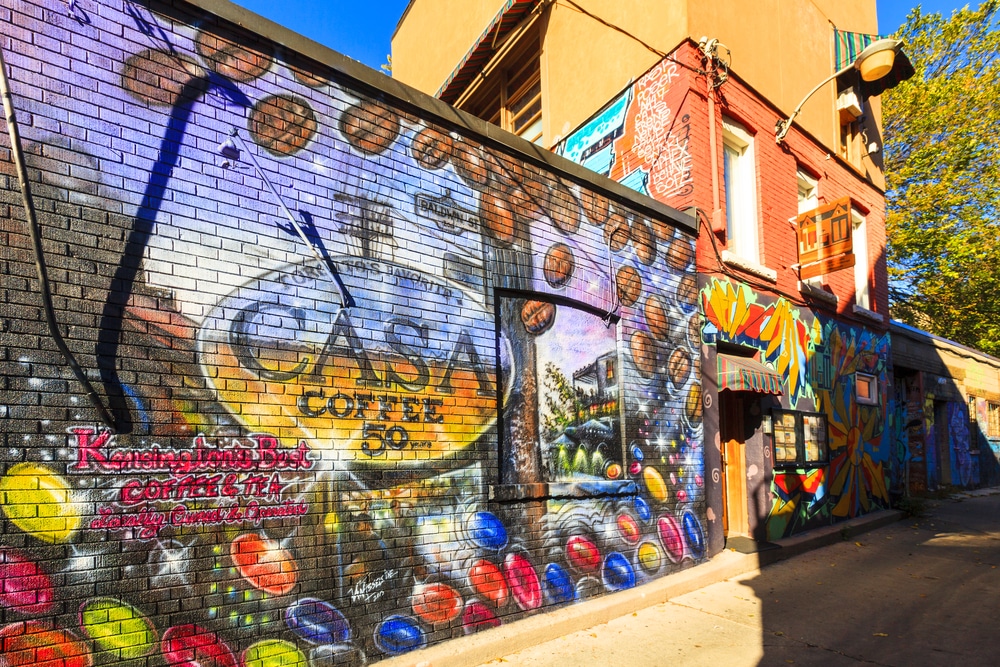
Highlights: MOCO Museum of Contemporary Art, Graffiti Alley, Trinity Bellwoods Park, Toronto Music Garden
Everything west of Spadina Avenue in Downtown is considered Westside. Some of the trendiest parts of the city are here, including Little Italy, King Street West, and Kensington Market. Westside is known for its hip eateries, bars, boutique stores, art galleries, and open studios. Graffiti Alley boasts some incredible street art and it’s a popular spot to capture cool selfies.
West Queen West is one of Westside’s best-known neighborhoods. It’s a hub for trendy boutiques, cafes, restaurants and galleries. In 2014 Vogue named it the second coolest neighborhood in the world.
Westside is within walking distance of Downtown and Harbourfront, but it’s also well-connected by metro, streetcar, and bus making it easy to get to the city center for sightseeing. The area is a little cheaper than the very center of the city. You can find some cool boutique hotels in the area such as The Thompson and Hotel Ocho on Spadina Avenue.
Old Chinatown for Foodies
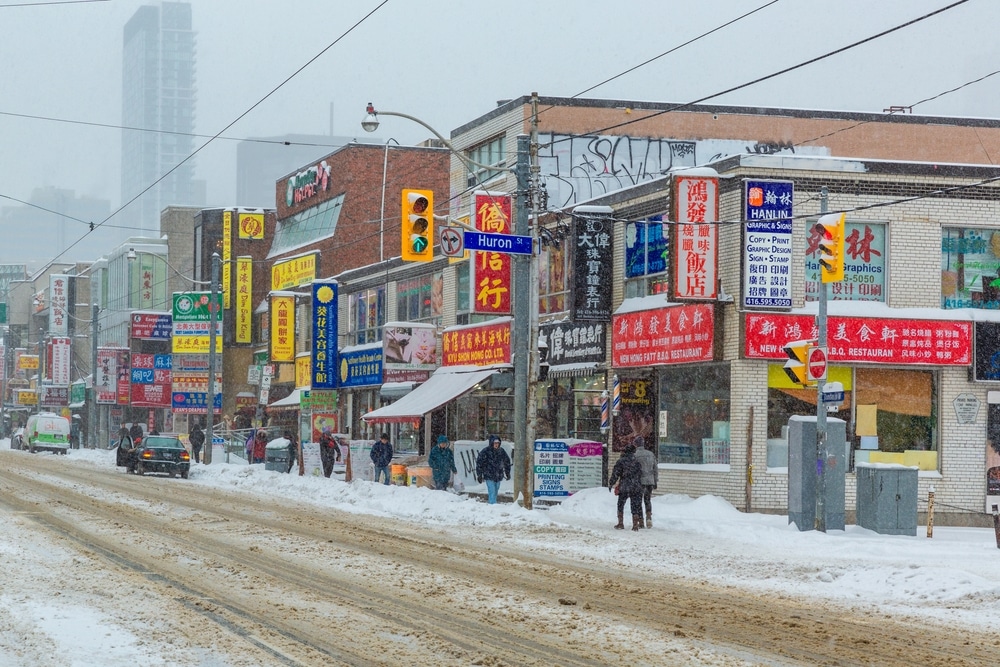
Highlights: Sonic Boom Record Store, Asian restaurants, stores and markets
There are six Chinatowns in Toronto, but the original and oldest one lies Downtown at the junction of Spadina and Dundas. The Chinese community has been established here since the 1870s. Some of the city’s best Asian restaurants can be found here, so if you want to eat delicious Chinese, Japanese, Thai, and Vietnamese cuisine, this is the neighborhood to do it in.
Old Chinatown also has an abundance of Asian-owned markets and shops where you can pick up fresh produce, herbal remedies, and souvenirs. Spadina Avenue is dotted with street food stalls where you can pick up snacks as you shop. The streets come alive with live music, dance, art, and performance during Chinese New Year and the Toronto Chinatown Festival.
There isn’t much choice of accommodation in Old Chinatown but there are a few budget-friendly hotels nearby. Most people opt to stay in nearby Downtown, but visiting Old Chinatown is essential for foodies.
The Annex for Budget Trips

Highlights: Royal Ontario Museum, The Royal Conservatory, Philosopher’s Walk
The Annex, which sits just above the major thoroughfare of Bloor Street, is one of the oldest neighborhoods in Toronto and it has a charming Old World feel. It’s home to the main University of Toronto campus which means lots of students hang out and live in the area. This gives it a youthful feel with plenty of trendy art galleries, eateries, and shops amongst the historic architecture.
The Royal Ontario Museum, an important Canadian cultural institution, lies in The Annex. The area is also home to The Royal Conservatory, a world-renowned music school that boasts Diana Krall and Sarah McLachlan as alumni. There’s great nightlife in the Annex. The area is well known for its affordable beer so take a tour of the pubs for a laid-back night on the town.
There are a few affordable hotels in the Annex, but the area sits right next to Yorkville where there’s more choice for those who want a little more luxury.
University Avenue, Queen’s Park & Discovery District for Culture

Highlights: Gardiner Museum, Lieutenant Governor of Ontario building, Legislative Assembly of Toronto building
University Avenue cuts through the attractive stretch of green space called Queen’s Park and runs past Toronto General Hospital. The southern portion of University Avenue is called the Discovery District, and it’s a commercial hub known for biotechnology research.
Queen’s Park is home to the Lieutenant Governor of Ontario and the Legislative Assembly of Toronto buildings, where the provincial government has sat since 1890. You can take a tour of these impressive buildings to learn more about their history. From here it’s just a short walk to the University of Toronto Campus.
There’s very little accommodation in this area but you can find a couple of options on the outskirts. Doubletree by Hilton and Marriott Downtown both sit right at the bottom of University Avenue.
Toronto Pearson International Airport for Short Stays and Business Trips
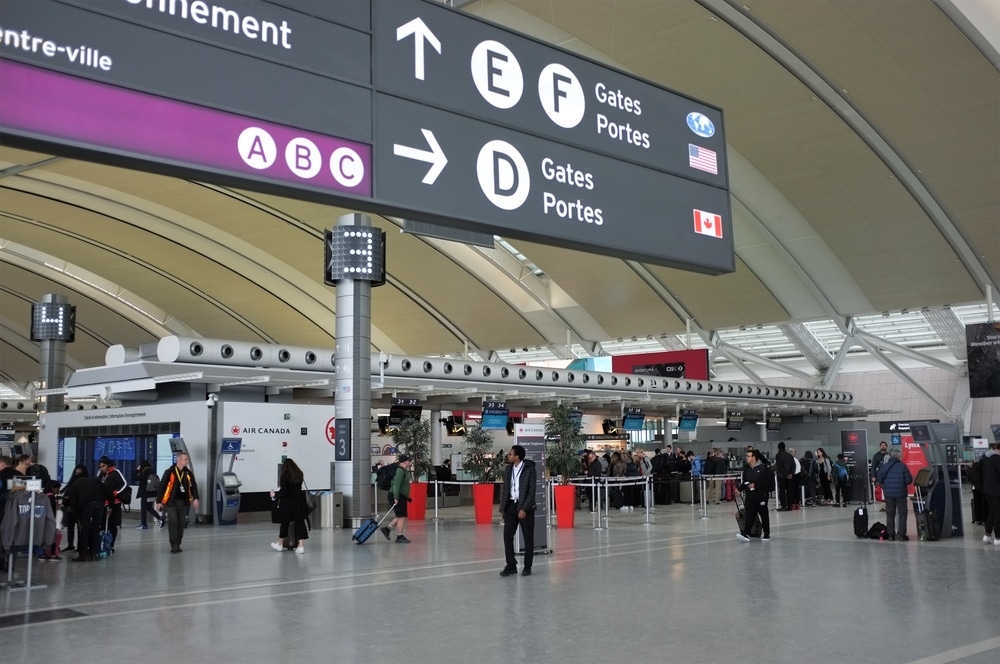
Highlights: Centennial Park
Toronto Pearson International Airport is 20 miles away from the city center but it’s easily accessible via bus, metro, or taxi. If you’ll be in Toronto for just a night or two, this might be the most convenient area to stay in. It’s also a popular base for those taking business trips because there’s a good mix of accommodation very close to the airport.
Although there are many chain restaurants in the airport itself, there are few high-quality eateries in this area. You’re better off using public transport to head further into the city for decent cuisine. There’s very little in the way of sights in the airport area, but nearby Centennial Park is a good spot to enjoy some green space in this otherwise built-up neighborhood.
There’s accommodation to suit all budgets near Toronto Airport, including offerings from Embassy Suites, the Westin, and Holiday Inn. Many hotels offer on-site parking which is ideal for those who plan to hire a car during their trip.
Choose Your Toronto Home Away From Home
Now you know which Toronto neighborhoods are the best areas to suit your budget and travel style, you can get started finding the perfect accommodation for your visit to this beautiful city.
